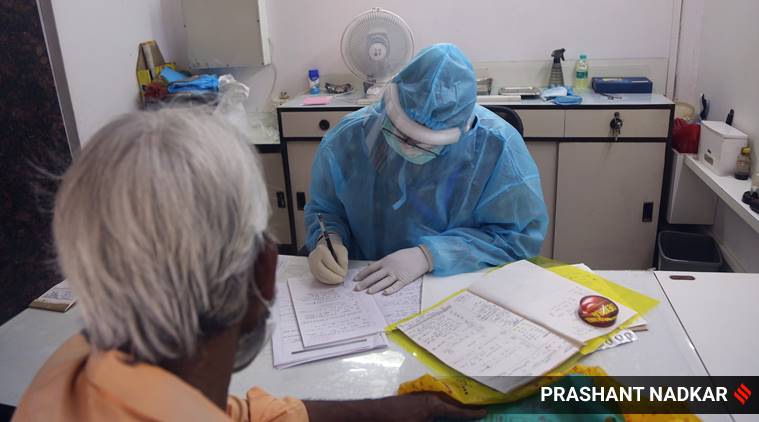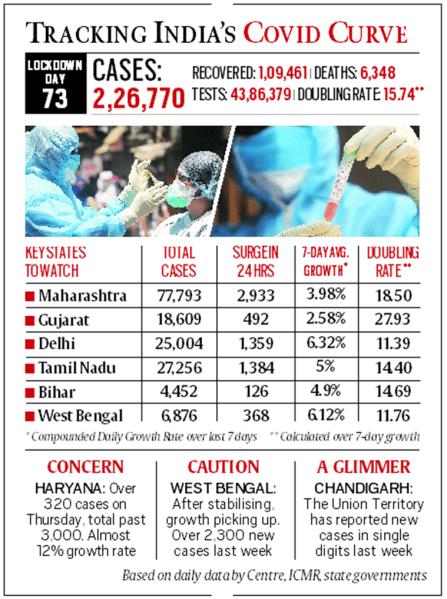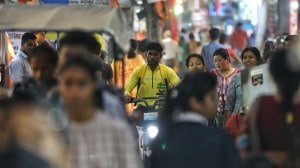- India
- International
Transmission slowest ever, Maharashtra load big factor now and later
Almost 25 states and Union Territories currently have growth rates higher than the national number, but the slower rates in Maharashtra, Gujarat, and Rajasthan have ensured that the growth at the national level continues to decline.
 A doctor treat a patient in Mumbai. (Express Photo: Prashant Nadkar)
A doctor treat a patient in Mumbai. (Express Photo: Prashant Nadkar)
Contrary to fears, gradual relaxations in the lockdown over the past month have not triggered a major surge in the novel coronavirus infections in the country.
The transmission rate, or the number of people getting infected by an already infected person, has been going down steadily — and is now the lowest since it began to be calculated early in the outbreak.
The transmission rate, also known as the reproduction number, R-value, or simply R, is a very good measure of how fast an epidemic is growing in a population.
Just before the first phase of the lockdown began on March 24, scientists at the Institute of Mathematical Sciences (IMSc) in Chennai had calculated R to be 1.83. That meant that every 100 infected people were transmitting the disease to another 183 individuals on average.
Due to the lockdown, this number declined to 1.49 and subsequently, to 1.29. But what is surprising is that it has continued to decline even after the restrictions have been eased, and people have been allowed to move around.

A new analysis by Dr Sitabhra Sinha and his colleagues at IMSc shows that the reproduction number is now down to 1.22 – which means only 122 people are getting infected on average by every 100 already infected people.

It is important to note, however, that the beginning of the end of an epidemic can be said to have started only when the R-number falls below 1.
Also, while the decline in the R value for the country as a whole even after the economy has been reopened is encouraging, the story is much more complex, and less rosy, at the level of the states.
In fact, the relaxation of the curbs has coincided with a surge of infections in a number of states – Assam, Bihar, Odisha, Kerala, West Bengal and, more recently, Haryana, Uttarakhand, Chhattisgarh, and Delhi.
In many of these states, the R-value has risen significantly during this time. Uttarakhand, for example, has an R-value of more than 2 – the highest in the country right now. Haryana has an R value of 1.9, and Assam is close to 1.7.
These state-level surges have, however, been balanced at the national level by the slowdown of the infection in Maharashtra – the state that has more than 35 per cent of India’s overall case load and has, therefore, exerted the dominant influence on the national picture.
Maharashtra has been slowing for some time now, and Dr Sinha’s calculations show that its R-value is currently just 1.18 – less than the national average.
“The dominance of Maharashtra has been such that it has been able to compensate for the rise in the R-value that we have seen in several states. It has dragged down India’s R-value along with it,” Sinha told The Indian Express on Friday.
Dr Sinha’s calculations on R-number are in line with, and validate the growth trends that have been pointed out in this newspaper. Maharashtra’s seven-day compounded growth rate of total positive cases has fallen below the national number for the first time in over two months, The Indian Express reported on June 3.
The state has also been the reason for the gradual slowing down at the national level for the last three weeks.
Almost 25 states and Union Territories currently have growth rates higher than the national number, but the slower rates in Maharashtra, Gujarat, and Rajasthan have ensured that the growth at the national level continues to decline.
While a slowdown in Maharashtra bodes well for India in the short term, there is a flip side to it as well.
As it slows down, the state will also progressively lose its dominant grip over the national curve, which will then begin to respond more actively to the changes happening in other states.
Also read | 112 in a month: Why Covid death rate in Jalgaon is four times India’s
Even the R-number at the national level would become more representative of what is happening in other states.
This process may in fact, have begun already, Dr Sinha said, adding that its impact would become evident in the coming days.
“I expect the national R-number to begin to rise after a couple of weeks. Maharashtra’s curve right now seems headed to progressively disentangle itself from the national curve, and then we will see a greater randomness in R-number at the national level. It will respond to the changing numbers in several states and, therefore, the kind of unidirectional reduction that we have seen in the last couple of months might not be there,” he said.
Apr 20: Latest News
- 01
- 02
- 03
- 04
- 05






































